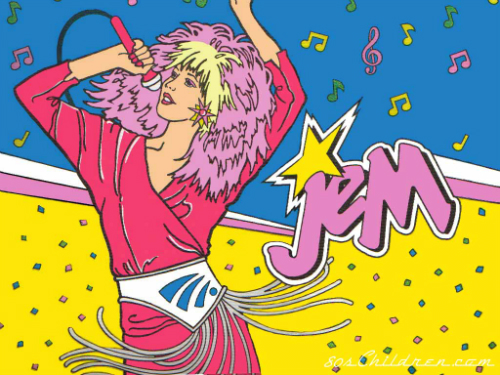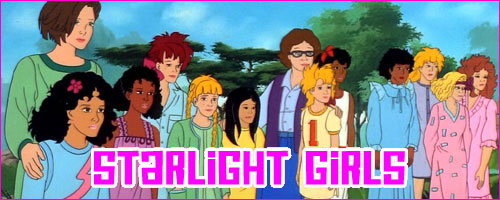This repost by Amanda Rodriguez appears as part of our theme week on Children’s Television.
As a little girl growing up in the 80s, I loved the show Jem and the Holograms. I confess that I still have a bunch of the songs from the show that I listen to from time to time (occasionally subjecting my spin class attendees to a Jem track on my workout playlists). Looking back now as an adult feminist, I’ve wondered how the show influenced me and whether or not that influence was a positive thing. *I did a similar assessment of another of my much-loved 80’s cartoons called: She-Ra Kinda Sorta Accidentally Feministy.*
There are a few potential not-necessarily-empowering aspects of Jem. Firstly, the show is fashion-obsessed and revolves around the characters’ fashionability. Unlike most cartoons where the characters mostly wear the same outfit in every episode, the thin female bodies of Jem‘s characters are adorned in multiple wardrobe changes often within a single 20-minute episode. Fashion and modeling, we know, are traditionally coded as female. The fashion world is extremely hard on women, placing undue emphasis on their bodies, especially on the thinness of those bodies. The drummer (and Black bandmate) Shana, however, designs clothing, so there is an aspect of fun creative expression at play here. Not only that, but the band Jem and the Holograms gets into the world of fashion and music in order to maintain the foster home for young girls that they run.
In this light, being on the cutting-edge of fashion, making money, being famous, and maintaining their record label (Starlight Music) is all a means to a philanthropic ends. The band often performs benefit concerts, singing many songs that deliver a positive message about fair play, hard work, creativity, education, and friendship to its young, predominately female audience. Jerrica Benton (Jem’s alter ego) must become a savvy business woman in the advent of her father’s death in order to run her inherited huge record label while living with her beloved foster girls, trying to give them good, happy lives. Jerrica and her friends are capable, ambitious women who thrive in the business world and do so for noble reasons. That type of female representation is all too rare in any pop culture medium, and it definitely had a positive effect on my impressionable younger self.
Another aspect of the show that could be a negative for little girls was all the female rivalry. The primary focus of the show was the often high-stakes band rivalry between Jem and the Holograms and their nemeses (another all-female band), The Misfits.
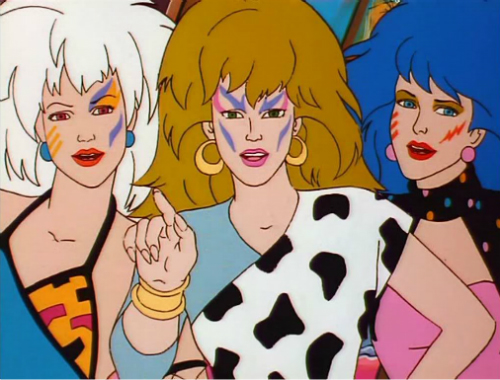
The Misfits were mean, reckless, and ruthless in their pursuit to beat Jem at everything. They’d lie, cheat, commit crimes and sabotage, and endanger the lives of Jem and her bandmates in order to win at any cost. They even had a song called “Winning is Everything.” True story.
[youtube_sc url=”http://www.youtube.com/watch?v=CMlneySmI3g”]
Though Jem passes the Bechdel Test with flying colors, this dangerous female rivalry is troubling, reinforcing mainstream media’s insistence that women can’t be friends; they must, instead, compete for resources, men, and general approval. Instead of the bands being able to cooperate and collaborate, they are mostly at each other’s throats (with The Misfits, of course, being the instigators). The upside of this rivalry is that the major players are all women. The characters with all the talent, power, and agency are women. The epitome of this is the all-powerful matriarchal figure of Synergy. She’s a basically sentient hologram generating computer system. She gets Jem and her crew out of countless jams, operates as home base for their operations, and acts as a concerned, maternal mentor for them. Though Synergy is a computer system, she has awesome power and Jerrica/Jem often goes to her for counsel.
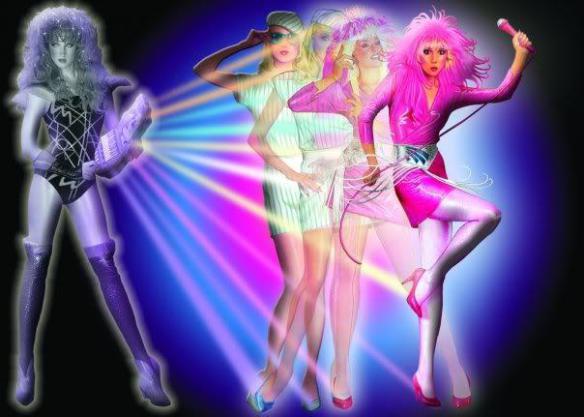
Not only that, but even the cruel Misfits are given depth over time. My favorite character (on whom I had a serious girl-crush) was Stormer, the blue-haired Misfit who was a bad girl with a heart of gold. When her bandmates crossed the line, she would always undermine their machinations in order to do the right thing, often saving the day. We also learn that Pizazz, the ringleader and front woman for the band, struggles with her former identity as: Phyllis, a rich girl with a neglectful father whose approval and attentiveness she could never garner. Despite the contentiousness of the rival bands’ relations, the fact that women are the primary actors and reactors gives the show a variety of female perspectives and permutations, which is what’s so often lacking in current female representations in film and on TV.
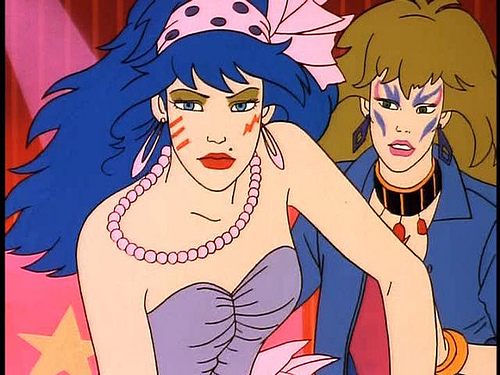
In fact, there are hardly any male characters in the show at all. There are only two to speak of: Jem/Jerrica’s love interest and road manager, Rio Pacheco, and The Misfits’ slimy band manager, Eric Raymond. Later the lead singer of The Stingers, Riot, enters the scene with his ridiculous hair and obsession with Jem. These male characters’ relevance and even usefulness was often in question. Eric was incompetent at all of his scheming in a distinctly Road Runner style. Jem/Jerrica couldn’t even confide her secrets in Rio, and he was often left waiting in the dark for situational resolutions. I often questioned how healthy for young girls the representation of the love triangle involving Rio, Jem, and Jerrica was. It was bizarre that Jem was Jerrica, so Rio was essentially cheating on his girlfriend…with his girlfriend. There was even an episode where Jerrica gets tired of being herself and her Jem personae, so she dons a hologram of a completely new appearance. Rio falls in love with her, too, and they share a kiss. Though the inherent deception on all sides of the relationship is not good role modeling, maybe it’s important that Rio loves Jerrica no matter what physical form she takes on.

The band itself, Jem and the Holograms, was also surprisingly racially diverse. The drummer, Shana, was Black, and the lead guitarist, Aja, was Asian. They later added a new drummer, Raya, who was Latina, when Shana took up bass guitar. Though the front woman for the band (who couldn’t actually play an instrument) remained a white woman, with the addition of Raya, there were actually more women of color in the band than white women. I don’t know if I’ve ever seen that kind of ratio on a TV show that wasn’t specifically targeted at people of color.
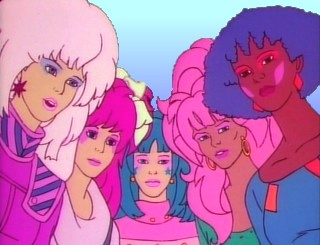
Though the show’s focus on romantic love, fashion, and female rivalry are of dubious value, there are definitely a lot of good things going on with Jem and the Holograms: the notion that fame and fortune should be used for philanthropic means, that female friendships can be strong and form an important network of support, that a sense of community is crucial, especially that of an older generation of women actively participating in that of teenage girls, that the arts should be respected and fostered, and that the virtues women should value in themselves should include honesty, compassion, fairness, determination, and kindness. Maybe I’m biased because I always thought the show was “truly outrageous,” but the good seems to outweigh the bad, giving us a series about women that tried to teach little girls how to grow up to be strong, ethical, and believe in themselves.
Bitch Flicks writer and editor Amanda Rodriguez is an environmental activist living in Asheville, North Carolina. She holds a BA from Antioch College in Yellow Springs, Ohio and an MFA in fiction writing from Queens University in Charlotte, NC. She writes all about food and drinking games on her blog Booze and Baking. Fun fact: while living in Kyoto, Japan, her house was attacked by monkeys.
